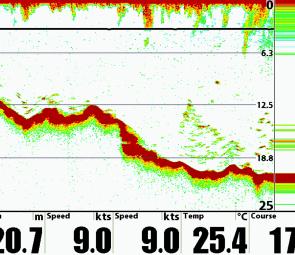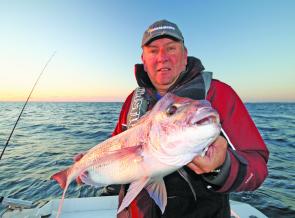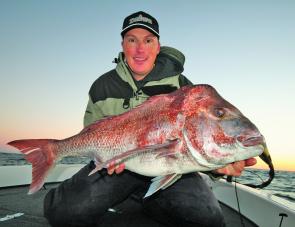Basic techniques for snapper fishing
SECTION: features
HEADER: Features
Facts
ILLUSTRATIONS:
MAPS:
NOTES:
Snapper would have to be one of the most popular fish along the coastal reefs of NSW. Put up a photo of a good snapper and it quickly turns heads.
I worked at the Sanctuary Cove Boat Show last year and our charter operation, RU4REEL Charters, was just being launched. I was asked what fish would be a good one to put on the banners advertising the venture.
I didn’t even need to think about it – it had to be a snapper. Sure enough, at the show a few weeks later the fish that stopped most people was the snapper and yet many folks still struggle a bit to consistently catch enough of these prized sport and table fish.
As with any type of fishing, if you aren’t in the right place then you won’t be catching your target species.
Snapper are often found around good bottom structure, like hard reef or gravel. They are opportunistic feeders and are just as happy scavenging crabs or prawns off the bottom as chasing down squid or pilchards in mid-water, and sometimes even off the surface.
An inspection of their stomach contents usually shows a variety of food types, ranging from worms and sea urchins to prawns, squid and octopus. These fish generally move around until they find an area that holds enough sustainable food.
Basically, if you find the areas around reef or gravel that have a good supply of baitfish then you are in the right area and the snapper shouldn’t be far behind.
Snapper are no different from the majority of predatory fish in that they feed best at times of low light. Early morning and late afternoon are always going to be the best times to catch them, especially the more wary larger fish.
Boat traffic also plays a big role and having the odd boat driving around the place you are trying to fish is not a great help.
This is mostly the case in shallow water; the farther out you tend to fish the less boat traffic you seem to find.
Winter is snapper time in NSW, with the latter part the prime time on the northern coasts.
Cold weather and whale activity seem to go hand in hand when targeting reds. Some of the most beautiful sunrises I have experienced have been while fishing for snapper on a balmy Winter morning with whales breaching not far off the reef.
There are a few different ways to target reds and they all work at different times with varying results. Let’s take a look at them in a bit more detail.
The tried and proven technique of bottom bouncing has been around for ages. The humble paternoster rig that consists of a reasonably-sized lead weight at the bottom of the rig followed by two droppers that run off the main line about 40cm from the weight and 40cm from each other.
Tie on a set of hooks to the droppers and you are away. For general work I prefer a 4/0 Mustad circle hook on one dropper and a normal J-hook on the other, maybe a 4/0 Octopus or Baitholder pattern. When the reds vary widely from sub-legal to knobbies and there’s the chance of some kings, jew or other by-catch, I’ll go for 2/0 Mustad Big Gun hooks, which are strong enough to tame all these fish.
Try to use the freshest bait you possibly can. Tackle stores generally stock good-quality frozen bait like squid and pilchards and these are a great starting point. Try to mix up the bait on your dropper rigs to see what the fishes’ preference is on the day.
The key to catching fish consistently with a dropper rig is to keep it as close to the bottom as you can and where possible, actually let your sinker rest on the bottom. That way the bait appears natural in the water and isn’t moving up and down as the boat rolls.
Keeping the bait nice and still will dramatically improve the number of bites you get. Snapper have hard mouths and unless you are using circle hooks on your dropper, it pays to strike fairly hard when you get a positive bite.
Once the fish is hooked, try to keep a steady wind going instead of a lift-and-wind retrieve because when you drop your rod tip, the heavy sinker pulls the fish’s head down. This up-and-down motion can cause the hook to tear a large hole in the fish’s mouth and can result in a lost fish.
This would have to be the deadliest technique that you can use on snapper and it generally catches bigger fish because of the natural way that the bait is presented and because snapper often suspend off the bottom.
If you have a quality sounder you can actually make out individual fish off the bottom and these are the ones that you target floatlining. Current also can make bottom bouncing excessively difficult and often the only way to fish in current is by using the floatlining technique.
It is a simple rig that consists of a free-sliding ball weight above a three-hook set of gangs or a double hook rig; the Mustad 4200 is the classic ganging pattern but all hook companies have appropriate patterns in their ranges.
I like the non-offset hooks that allow for easy rigging up without adding twist to the bait. It is vital to ensure that the bait doesn’t spin, to appear as natural as possible.
My bait of choice is a whole pilchard but if you find that smaller fish are picking the bait off then a long thin fillet of fresh flesh bait or a whole squid will also work.
The bait is dropped over the side and allowed to slowly sink to the bottom at a semi-controlled rate. Keep it going until you either get a bite or you reach the bottom.
Most bites come as a strong surging take or a few taps followed by that surging grab. When you get the bite, allow a second or two for the line to pull tight and then strike.
Floatlining is all about the sink rate of your bait – too fast and you are going through the suspended fish too quickly, too slow and you aren’t getting there. A 45° or slightly more angle of your line is a good indication.
A good tip is for each angler to try a different sinker weight at the start and then see who gets the most bites. If the wind or current increases then you may need to upsize the ball sinker slightly to counter it.
Floatlining can be undertaken on the drift or at anchor but really comes into its own when the boat is anchored up-current of fish-holding structure and a steady, sparse stream of berley
This can be a deadly technique for snapper when you get it right, but can also be extremely frustrating if you get it wrong.
As with floatlining, the key to catching snapper on plastics is very reliant to selecting the right weight of jig head.
In the shallower water from 10m to 30m, a 1/2oz to 1/2oz jig head should suffice. Water from 30m to 50m requires something more in the line of 1/2oz to 3/4oz and once you head deeper, you can start to look at 1oz and 11/2oz heads to effectively get your plastic into the strike zone.
Choice of soft plastic is not as important as getting the technique right. The key is to allow the plastic to fall on a fairly slack line, watching the line intently for any sign of a bite.
Some bites are a simple flick of the line as the plastic is sinking while other fish hit like steam trains.
Use the logic of when in doubt, strike, and you will catch a lot more fish.
The hardest part about chasing reds with soft plastics is realising when the lure gets to the bottom, especially when there is a fair bit of current or wind to contend with.
As the plastic hits the bottom you will need to hop it immediately to stop it from snagging, as well as to keep it looking natural.
Almost all your bites come when the lure is dropping back down to the bottom after a hop or on the initial drop after you have cast the lure.
Try to cast your plastic in the direction that you are drifting because this allows your lure to sink unimpeded and also gives you the opportunity to present your lure to fish that have not had the boat drift over them.
This is obviously a lot more important in shallow water than in the deep.
Snapper are great fish to eat and a joy to catch and hopefully this will give you a better insight into how to catch them. And remember, limit your catch, don’t catch your limit.
Facts
THE ELECTRONIC PLOT
Having a quality sounder on your boat is very important to the success of catching snapper. We run a Humminbird 1198 sounder/GPS combo on our charter boat and its definition is that good that I will not bother fishing a section of reef unless I can see fish marking up.
Which technique I suggest clients should use depends on how the fish are marking up on the Humminbird. If they are up off the bottom then I suggest floatlining or soft plastics; if the fish are marking up tight to the bottom then I use bottom droppers.
I pay great attention to the sounder/plotter screen, noting fish on the bottom, the direction the boat is drifting and marking significant events on the plotter. Knowing how to get the best out of your electronics, especially in the deeper water, is always going to tip the scales in your favour.

You can clearly see a school of decent-sized fish sitting on the drop-off on this good bit of reef. A soft plastic rigged on a 3/8oz jig head, or a lightly weighted floater, would be the preferred technique here.

On this screen shot there are snapper showing off the bottom as well as fish holding close to the bottom. A bottom-bouncing rig or a slightly heavier weighted floater would be the go.

This good-sized snapper ate a 6” plastic rigged on a 1/2oz jig head in 48m of water. On the sounder you could see the fish suspended about 30m down.

The author with 9.8kg of spangled emperor. The by-catch when chasing snapper can be just as good as the target species at times

Snapper like this are a real option when floatlining.

Big snapper are trophy fish for almost anyone who fishes offshore.

Jew can also be another surprise by-catch when using any of the three techniques discussed in this article.




